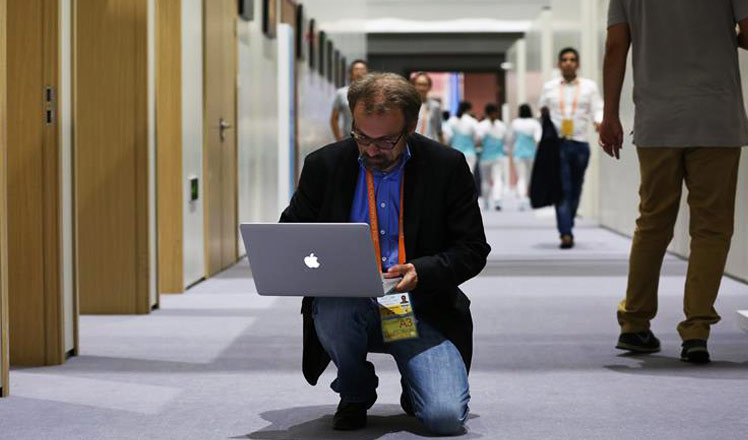Miami beckons Chinese to beaches and all
Updated: 2016-09-05 10:03
By Amy He in New York(China Daily USA)
|
||||||||
S. Florida city looks to explain benefits of sand and surf to potential tourists
Convincing Chinese to visit Miami requires a lot of persuasion and education about American beach and water culture.
"[Chinese] interest in beaches is minimal. One day at the beach is already adequate, but [beaches] are an important part of what Miami has to offer," said Bruce Orosz, chairman of the Greater Miami Convention & Visitors Bureau (GMCVB), Miami's official marketing organization.
"So when we have Chinese visitors or delegations, we want to take people to explore by boat, and they come away being amazed that Miami has waterways that makes navigating around this town so amazing," he said.
Of the major US tourist cities devoting more marketing resources to attract the Chinese, Miami is faced with two quandaries that other gateway cities do not have: The city has no nonstop flights to and from any Chinese city (though Orosz said that's something he and his team are working on), and Miami does not have the same brand recognition with Chinese travelers that New York, Los Angeles or even Boston has.
"Last week, I had a guest here from China who's a fund manager and he said he frankly didn't know what to expect," Orosz said. "He didn't really know the depth of what we had to offer in this town."
Because of the lack of direct flights, it is difficult to measure how many Chinese visit Miami, and the tourism agency only has estimates based on how many Chinese transit through Miami's airports.
The Miami market generated more than 55,000 Chinese passengers in 2014, though that figure also includes those who can be headed to another destination with a layover in Miami. Orosz said that since 2014, there has been more and more interest in Miami from China.
"We're starting to see some interest and desire in the town. There have been [media articles] about North Miami becoming a destination in the future, call it the future Chinatown of Miami," he said.
"There are acres and acres, and they're talking to numerous Chinese investors about trying to build a community, so we feel that there's tremendous opportunities going forward with the expansion," said Orosz.
Miami is increasingly a city of interest for Chinese investors who are shopping for real estate development projects through the federal EB-5 program, which grants visas for investors and their families who invest at least $1 million ($500,000 in certain areas) and create at least 10 jobs.
In November 2015, the Panorama Tower in Miami, the tallest building on the Eastern Seaboard, reportedly received numerous inquiries from Chinese investors interested in the development.
Orosz says that the GMCVB team is working not only with tour operators but also meeting planners and destination managers to promote Miami as a place of business and leisure. Representatives also travel to various trade missions to China throughout the year.
"It's a full cadre of what you would hope for from a tourism perspective for us to touch as many Chinese travelers as possible, so we're going through the entire specter.
"We have material that we distribute; we're hosting many delegations that are coming into town, with the hopes that when they go back to China, with the help of our representatives, that they'll continue to promote the activities that we have here in Miami that we feel a Chinese consumer would really enjoy," he said.
The GMCVB is developing a TV program with a major Chinese television group that will introduce Chinese viewers to Miami, though Orosz declined to disclose more details.
amyhe@chinadailyusa.com
- Xi tells Park China opposes deployment of THAAD in ROK
- Singapore confirms 27 new cases of Zika infection
- Russia, Britain agree to mend ties
- EU can't leave entire migration issue to mediterranean countries: official
- Rousseff appeals impeachment to Supreme Court
- Europeans displeased with their education systems

 In pics: Journalists cover G20 Summit in Hangzhou
In pics: Journalists cover G20 Summit in Hangzhou
 Air attendant 'incubator' welcomes freshmen
Air attendant 'incubator' welcomes freshmen
 Evening gala for G20 summit held in Hangzhou
Evening gala for G20 summit held in Hangzhou
 First Lady fashion: Rhapsodies in blue
First Lady fashion: Rhapsodies in blue
 Hangzhou: A city of bridges in East China
Hangzhou: A city of bridges in East China
 Commemorative G20 stamps a hit at media center
Commemorative G20 stamps a hit at media center
 Ten photos from around China: Aug 26- Sept 1
Ten photos from around China: Aug 26- Sept 1
 Hangzhou: Paradise for connoisseurs of tea
Hangzhou: Paradise for connoisseurs of tea
Most Viewed
Editor's Picks

|

|

|

|

|

|
Today's Top News
Trump outlines anti-terror plan, proposing extreme vetting for immigrants
Phelps puts spotlight on cupping
US launches airstrikes against IS targets in Libya's Sirte
Ministry slams US-Korean THAAD deployment
Two police officers shot at protest in Dallas
Abe's blame game reveals his policies failing to get results
Ending wildlife trafficking must be policy priority in Asia
Effects of supply-side reform take time to be seen
US Weekly

|

|







